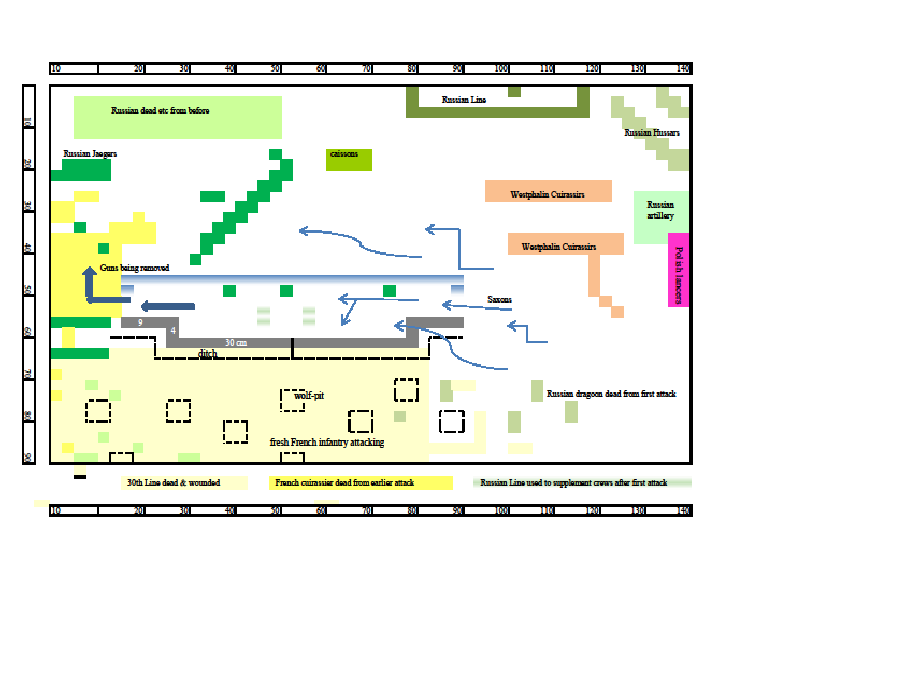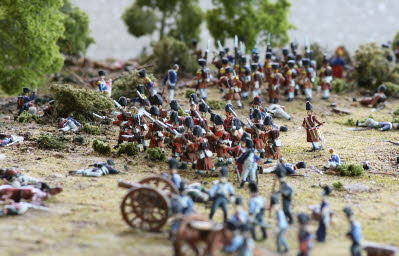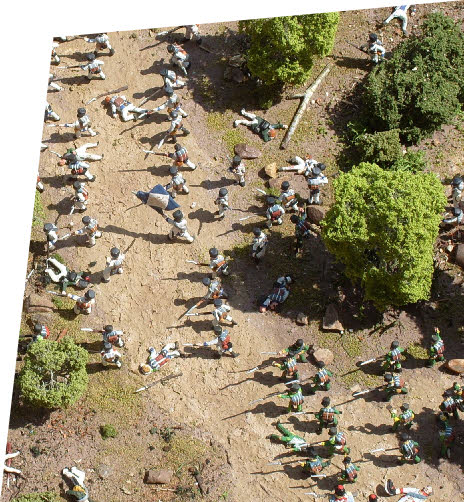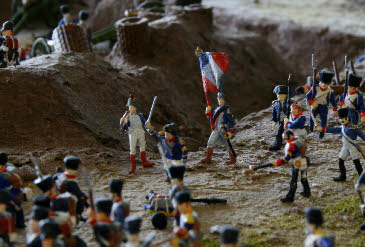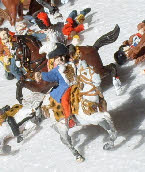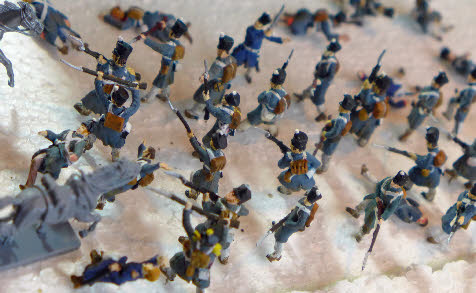Borodino to Waterloo: Rayevsky’s Redoubt, the wounding of the Prince of Orange &
d’Erlon’s attack
The follow up models to the Borodino fleches - www.borodino1812.co.uk
Three new Napoleonic dioramas (and one special English Civil War)-
ONE Phase 2 of The Battle of Borodino Diorama Project
Way back in the 1980’s when the concept was conceived, the idea was to make three
complementary dioramas of the battle: the fleches (phase 1 completed), Rayevesky’s
Redoubt and the Guard squares. The second has been started but is currently on
hold pending other mini projects.
TWO Waterloo - D’Erlon’s Attack
Built to meet the Battle’s 200th anniversary in June 2015 .......... and finished
on the 17th June 2015!

Borodino was notable for the degree of cavalry involvement despite the terrain not being particularly suitable for horses. And this diorama will show the unique event of calvary taking a fortification.
The moment to be portrayed is when the two Saxon cavalry units have attacked from the south, entering through one of the gaps left at either extreme to service the guns. Only a few troopers are into the enclosure whilst their comrades are both behind and attacking around the back. The Russian Jaeger regiment that is to the immediate north of the redoubt is trying to stop them whist at the same time attempting to fend off the attacking French infantry.
Why the title: Borodino to Waterloo?
Borodino can firmly be identified as the turning point of the Napoleonic War. Not only did Napoleon fail to destroy the Russian Army thus ensuring his eventual defeat in the 1812 War but his losses of so many experienced soldiers undermined his ability to wage successful war in the following years. This was especially true of his cavalry which never fully recovered. The Russians, by carrying the war across the border in 1813, facilitated & encouraged the anti-French coalition of Prussia, Austria, Sweden and other states that fought and eventually defeated Napoleon in 1814. His ‘100 days’ in 1815, of course, led to the decisive Battle of Waterloo
To replicate in 1:72 scale the counter-attack on d’Erlon by the Netherlands infantry (Dutch & Belgian troops) and the Inniskilling dragoons just at the moment when these troops just made contact. North to south on the diorama board:
27th Jaegers in line (generally not having moved) still firing at the French (west side of board)
7th Line flank companies who had moved back in line with the 27th when bulk of Netherlands troops withdrew
7th Line centre companies reformed in line, returning & attacking the French ,
Netherlands & French dead/wounded from previous fire fight over the road
French column 1st regiment /1 & 2nd battalion 3 +3 ranks
The Inniskillings engaging from the French front and east flank
Perhaps because there are so many sources of information from those who were there (but often written some time afterwards), there is quite amount of contradictions in various accounts of d’Erlon’s attack and repulse, (even down to what sequence the two left French divisions were)
The uncertainty as to whom and what occurred has been amazing: even the French Divisional sequence from west to east is debated in great depth, including on TMP Site in 2007. Donzelot to the left, Quiot to the right, or vice versa!? I’m now convinced that Donzelot's division was to the left and its 13th light & 17th line attacked La Haye Sainte whilst 51st & 19th took on the English under Kempt.
As always in life, you learn from your experiences. Previously, the concept and layout of the 2012 diorama was only in my mind: only when I started mixing up the ‘ground’ from newspaper paste, was the exact layout and positioning realised. Although generally meeting my vision, there were changes: for instance, the concept had included a French infantry column advancing up the slope. If it had been included, the soldiers in the middle of the diorama would have been too far away. Thus, the column never materialised.
For this Borodino diorama time I would plan the model in advance. Thus for starters this plan
Considerable research has highlighted how maligned the Netherlands soldiers have been in English language publications from 1815 onwards. Wellington downplayed their contribution in much the same way he did with the Prussians. Whilst the Netherlands troops had finally given way they had only after a fierce fire fight with the considerably larger attacking French forces of d’Erlon, adjoining English and Scottish soldiers had similarly withdrawn. Many of the Netherlands units had suffered severe casualty levels at the fighting 2 days earlier (as too had many of these English and Scottish units). Bernard Cornwall in his 2015 book on Waterloo joined the ranks of those repeating historical errors!
—--------------------------------------------------------------------------------------------------------------------------
THREE Waterloo - The Wounding of the Prince of Orange
Towards the early evening, French calvary (although no longer in mass formations) continued to probe & assault the main Allied positions, and are now supported by infantry since the fall of La Haye Sainte. Nassau troops are moved (in square formation) west to counter-attack these infantry and, whilst when being rallied by the Prince. He is shot in the left shoulder.
—----------------------------------------------------------------------------------------------------------------------------------------------------
The 1646 siege of Bridgnorth Castle

![]()
